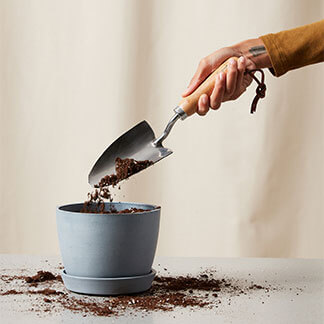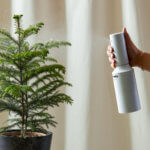First, let’s clean up your plant. This allows the plant to direct its energy to new healthy growth.
- Remove the entire brown fronds (they will not turn green again) or the affected portion with a pair of sharp scissors or pruning shears.
- Wipe the blades of your scissors with rubbing alcohol between each snip.
- You may need to trim your plant in stages because you never want to remove more than 20% of the affected leaves at one time–this could shock your plant.
Incredibly dry soil
Be sure you’re not underwatering your fern. Keep a consistent watering schedule when 25-50% of the soil volume is dry. Water thoroughly and discard the excess water in the saucer.
If you accidentally let your fern’s soil dry out completely, you may see fronds droop, crisp up, and leaves fall. If the soil is extremely dry all the way through the pot, a good soak is in order.
Here’s how to soak-water your plant:
- Place your plant in your sink or tub without the saucer. Fill your basin up with about 3-4″ of water. Make sure the water isn’t hot!
- Allow your plant to soak up water through the drainage hole in the bottom of the pot for at least 45 min.
- Feel the top of the soil after your plant has been soaking–has the water reached the top 2-3” of soil?
- If not all the soil feels saturated, water your Kimberly Queen slightly from the top of the soil to help speed up the saturation.
- When your plant’s soil is evenly damp, drain the sink/tub and allow the plant to rest while it drains thoroughly. Place the plant back on its saucer and back in its proper spot.
Keep in mind that when the soil goes from bone-dry to saturated, it can cause stress for your fern and may cause leaves to drop. Give it some time to adjust.
Not enough humidity
In the wild, ferns grow on the moist forest floor. They will do best in a very humid environment, such as a bathroom or kitchen. Here are some ways you can increase humidity for your fern: Try misting regularly, adding a pebble tray, or placing a humidifier nearby.
Temperature
Leaf curl often happens when your plant is too cold. Dry spots or dry leaf edges can also happen from constant temperature fluctuations like heaters. Make sure your plant is not in a drafty area, near a drafty window in the winter, or in the direct path of any open vents.










